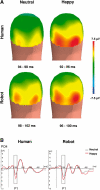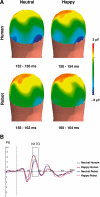Human brain spots emotion in non humanoid robots
- PMID: 20194513
- PMCID: PMC3023084
- DOI: 10.1093/scan/nsq019
Human brain spots emotion in non humanoid robots
Abstract
The computation by which our brain elaborates fast responses to emotional expressions is currently an active field of brain studies. Previous studies have focused on stimuli taken from everyday life. Here, we investigated event-related potentials in response to happy vs neutral stimuli of human and non-humanoid robots. At the behavioural level, emotion shortened reaction times similarly for robotic and human stimuli. Early P1 wave was enhanced in response to happy compared to neutral expressions for robotic as well as for human stimuli, suggesting that emotion from robots is encoded as early as human emotion expression. Congruent with their lower faceness properties compared to human stimuli, robots elicited a later and lower N170 component than human stimuli. These findings challenge the claim that robots need to present an anthropomorphic aspect to interact with humans. Taken together, such results suggest that the early brain processing of emotional expressions is not bounded to human-like arrangements embodying emotion.
Figures




Similar articles
-
Reading sadness beyond human faces.Brain Res. 2010 Aug 12;1348:95-104. doi: 10.1016/j.brainres.2010.05.051. Epub 2010 May 26. Brain Res. 2010. PMID: 20510891
-
Early and late temporo-spatial effects of contextual interference during perception of facial affect.Int J Psychophysiol. 2009 Oct;74(1):1-13. doi: 10.1016/j.ijpsycho.2009.05.010. Epub 2009 May 24. Int J Psychophysiol. 2009. PMID: 19470392
-
On dissociating the neural time course of the processing of positive emotions.Neuropsychologia. 2016 Mar;83:123-137. doi: 10.1016/j.neuropsychologia.2015.12.001. Epub 2015 Dec 11. Neuropsychologia. 2016. PMID: 26686550
-
Neurodynamic studies on emotional and inverted faces in an oddball paradigm.Brain Topogr. 2004 Summer;16(4):265-8. doi: 10.1023/b:brat.0000032863.39907.cb. Brain Topogr. 2004. PMID: 15379225
-
Perception of robotic actions and the influence of gender.Front Psychol. 2024 Jan 31;15:1295279. doi: 10.3389/fpsyg.2024.1295279. eCollection 2024. Front Psychol. 2024. PMID: 38356771 Free PMC article. Review.
Cited by
-
From Warranty Voids to Uprising Advocacy: Human Action and the Perceived Moral Patiency of Social Robots.Front Robot AI. 2021 May 28;8:670503. doi: 10.3389/frobt.2021.670503. eCollection 2021. Front Robot AI. 2021. PMID: 34124176 Free PMC article.
-
Emotion Processing by ERP Combined with Development and Plasticity.Neural Plast. 2017;2017:5282670. doi: 10.1155/2017/5282670. Epub 2017 Jul 31. Neural Plast. 2017. PMID: 28831313 Free PMC article. Review.
-
Separable processes for live "in-person" and live "zoom-like" faces.Imaging Neurosci (Camb). 2023 Nov 7;1:imag-1-00027. doi: 10.1162/imag_a_00027. eCollection 2023. Imaging Neurosci (Camb). 2023. PMID: 40799691 Free PMC article.
-
Anthropomorphizing Technology: A Conceptual Review of Anthropomorphism Research and How it Relates to Children's Engagements with Digital Voice Assistants.Integr Psychol Behav Sci. 2022 Sep;56(3):709-738. doi: 10.1007/s12124-021-09668-y. Epub 2021 Nov 23. Integr Psychol Behav Sci. 2022. PMID: 34811705 Free PMC article.
-
I, robot: depression plays different roles in human-human and human-robot interactions.Transl Psychiatry. 2021 Aug 21;11(1):438. doi: 10.1038/s41398-021-01567-5. Transl Psychiatry. 2021. PMID: 34420040 Free PMC article.
References
-
- Adolphs R. Recognizing Emotion from Facial Expressions: Psychological and Neurological Mechanisms. Behavioral and Cognitive Neuroscience Reviews. 2002;1:21–62. - PubMed
-
- Adolphs R. Emotional vision. Nature Neuroscience. 2004;7:1167–8. - PubMed
-
- Allison T, Puce A, McCarthy G. Social perception from visual cues: role of the STS region. Trends In Cognitive Sciences. 2000;4:267–78. - PubMed
-
- Alorda C, Serrano-Pedraza I, Campos-Bueno JJ, Sierra-Vazquez V, Montoya P. Low spatial frequency filtering modulates early brain processing of affective complex pictures. Neuropsychologia. 2007;45:3223–33. - PubMed
-
- Amaral DG, Behniea H, Kelly JL. Topographic organization of projections from the amygdala to the visual cortex in the macaque monkey. Neuroscience. 2003;118:1099–120. - PubMed

